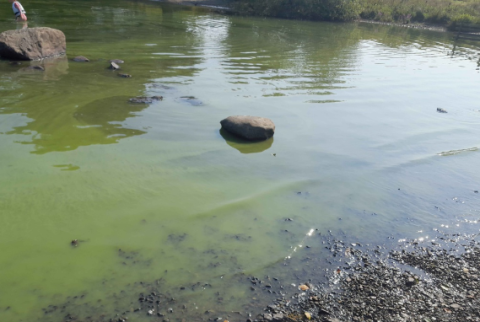Joint statement by the UK Centre for Ecology & Hydrology, Lancaster University and the Freshwater Biological Association
There continues to be much interest from the public and media regarding recent algal blooms and water quality on Windermere. In this explainer note, we aim to provide background information regarding these issues, based on long-term scientific research and evidence from our work on the lake.
What are cyanobacteria?
Cyanobacteria, also known as blue-green algae, are a naturally-occurring type of photosynthetic bacteria. They are found worldwide, including in lakes, rivers and oceans. Cyanobacteria are among the oldest organisms on Earth, originating around three billion years ago, and produced the first oxygen to enter the Earth’s atmosphere. They are an important component of many ecosystems, including within Windermere, where they have formed large populations since at least the end of the 1800s.
Why do cyanobacterial blooms occur?
Cyanobacteria are present in Windermere throughout the year, although usually at low levels. However, under certain conditions they can form dense blooms that result in obvious colouration of the lake water (often green or blue-green) and form surface ‘scums’ or ‘slicks’. Similar blooms occur in many waters around the UK, Europe and the world, especially in summer. Recently, there have been worldwide reports of increased cyanobacterial blooms associated with warmer than usual summer weather.
The current bloom on Windermere is likely to have been triggered by the warm, dry, stable period of weather over the past weeks. High water temperature allows cyanobacteria to grow rapidly. Many types of cyanobacteria are buoyant, meaning that they can remain near the surface of the lake, giving them maximum access to light for growth and keeping them within the warmest water, forming blooms. This gives them an advantage over other groups of algae, particularly when the lake “stratifies” into an upper warm layer and a lower cool layer, as occurs in many lakes during the summer, including Windermere.

High nutrient concentrations are needed to support large cyanobacterial blooms. Phosphorus is a key nutrient for cyanobacteria and can enter Windermere from multiple sources. These include wastewater from treatment works, combined sewer overflows and septic tanks, runoff from land surrounding the lake including agricultural land, and release of phosphorus from the sediments at the lake bed. However, other nutrients may also be important for controlling cyanobacterial blooms, in particular nitrogen. Some cyanobacteria have a further advantage over other algal groups when nitrogen is in short supply, because they can produce nitrogen for their growth from nitrogen gas dissolved in the lake water.
What impacts can cyanobacterial blooms have?
Cyanobacterial blooms can cause major water quality problems. The green discolouration of the lake water and the surface scums or slicks produced by a bloom can be unsightly, especially where buoyant species are concentrated by the wind into sheltered shores or bays.
These large accumulations normally disperse when the wind changes direction. Some species of cyanobacteria can produce toxins that are hazardous to humans who are in contact with water, resulting in skin rashes, eye irritation, vomiting, diarrhoea and fever. These toxins are also hazardous to animals and have caused the death of dogs, cattle and wild animals, including fish, in waters around the world.
Not all species of cyanobacteria produce toxins and a given species may not produce toxins all of the time. However, it is not possible to say whether a cyanobacterial bloom is producing toxins without detailed laboratory analysis. Therefore, as a precautionary measure, it is recommended to stay out of the water, and to keep pets out of the water, if a cyanobacterial bloom is present.

Cyanobacteria can affect the concentration of oxygen within the lake water. They release oxygen into the water during the day when they carry out photosynthesis. However, when they die, their decomposition by other micro-organisms removes oxygen from the lake water. This can have a detrimental effect on organisms such as fish or invertebrates that rely on oxygen in the lake water to survive, and can also accelerate the release of phosphorus from the sediment to the overlying water.
What can be done to control cyanobacterial blooms?
Climate change is likely to influence the frequency and intensity of cyanobacterial blooms across the world in the future. For example, UK Centre for Ecology & Hydrology (UKCEH) monitoring data from Windermere show that the average annual surface water temperature of the lake has increased by approximately 1.7 °C over the past 70 years. This is likely to favour the formation of cyanobacterial blooms in the future. Work at national and international levels to limit future climate change and associated increases in water temperatures at Windermere will help to limit future cyanobacterial blooms.
Locally, reducing the concentration of phosphorus and nitrogen in Windermere will also help to reduce the frequency and intensity of cyanobacterial blooms. Long-term data collected by UKCEH show substantial reductions in the concentration of nutrients within Windermere since the early 1990s, largely due to reduced inputs from wastewater treatment works. However, this has not been sufficient to offset the increased growth of cyanobacteria triggered by climate change and so further nutrient reductions will be required to limit future cyanobacterial blooms. This will require action and investment to reduce nutrient inputs to the lake from each significant source, including both wastewater and runoff from land in the catchment.

Where can I get further information?
In February 2022, Freshwater Biological Association (FBA) produced an information note ‘The State of Windermere’ which summarises the current scientific understanding of water quality and the factors affecting it. The note can be accessed via the FBA website.
For further information about cyanobacterial blooms, including tracking where blooms occur and being able to report sightings, please see the UKCEH Bloomin’ Algae app.
This note was produced by Ben Surridge (Lancaster University), Stephen Maberly and Steve Thackeray (UKCEH) and Simon Johnson (FBA).